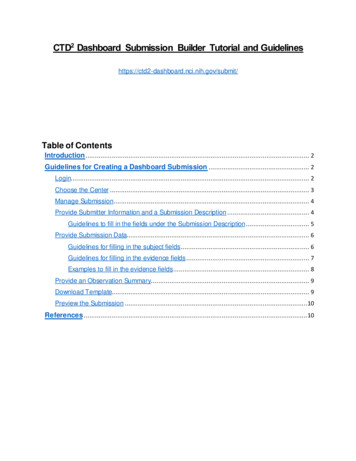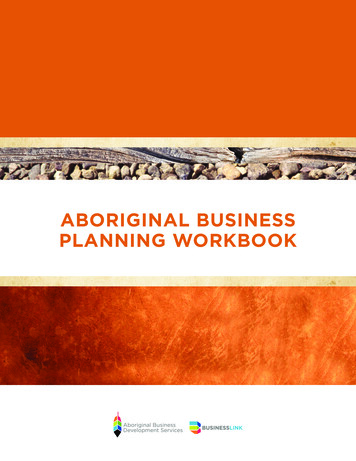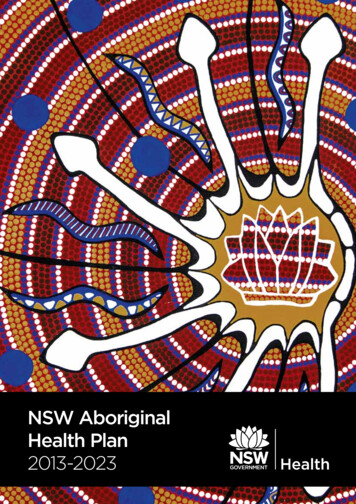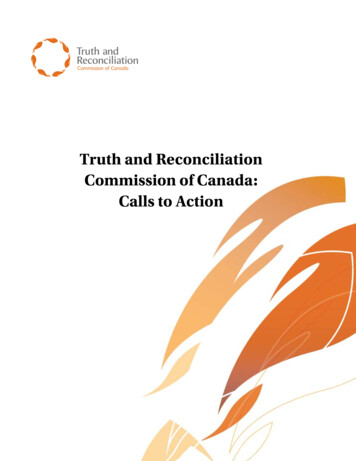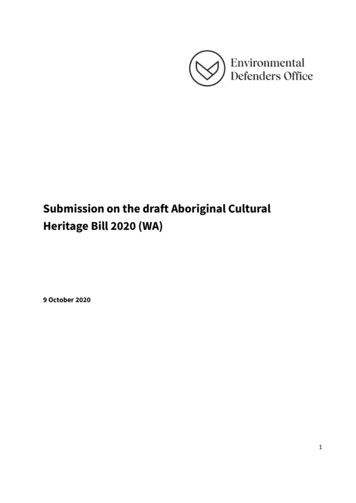
Transcription
Submission on the draft Aboriginal CulturalHeritage Bill 2020 (WA)9 October 20201
About EDOEDO is a community legal centre specialising in public interest environmental law. We helppeople who want to protect the environment through law. Our reputation is built on:Successful environmental outcomes using the law. With over 30 years’ experience inenvironmental law, EDO has a proven track record in achieving positive environmentaloutcomes for the community.Broad environmental expertise. EDO is the acknowledged expert when it comes to thelaw and how it applies to the environment. We help the community to solveenvironmental issues by providing legal and scientific advice, community legal educationand proposals for better laws.Independent and accessible services. As a non-government and not-for-profit legalcentre, our services are provided without fear or favour. Anyone can contact us to get freeinitial legal advice about an environmental problem, with many of our services targeted atrural and regional communities.Environmental Defenders Office is a legal centre dedicated to protecting the environment.www.edo.org.auSubmitted to:Department of Planning, Lands and Heritage (WA)Sent via email only: AHAreview@dplh.wa.gov.auFor further information on this submission, please contact:Lauren Butterly (Perth Office)Lauren.Butterly@edo.org.au2
A Note on LanguageWe acknowledge that there is a legacy of writing about Aboriginal and Torres StraitIslander peoples without seeking guidance about terminology. We also acknowledge thatwhere possible, specificity is more respectful. More generally, we have used the termAboriginal people in this submission as it is the nomenclature used in the draft AboriginalCultural Heritage Bill 2020 (WA). We acknowledge that not all Aboriginal and Torres StraitIslander peoples will identify with that term and that they may instead identify using otherterms or with their immediate community or language group.EXECUTIVE SUMMARYAs noted at the beginning of the reform process in 2018, and then reinforced by thedevastating destruction of Juukan Gorge, it is beyond doubt that the WA Aboriginalcultural heritage legislation needs a major overhaul. In this context, EDO welcomes theneed for reform and many elements of the draft Aboriginal Cultural Heritage Bill 2020 (WA)(the ACH Bill).There is an urgent need to reset the balance in favour of Aboriginal people. The ACH Billmust be judged against the fundamental principle that Aboriginal people must give theirfree, prior and informed consent in relation to decisions that impact protection of theirheritage. EDO set out, in detail, the application of these principles to Aboriginal culturalheritage in our Submission to the Inquiry into the destruction of 46,000 year old caves atthe Juukan Gorge in the Pilbara region of Western Australia (Rio Tinto Inquiry).1There are several positive elements in the ACH Bill, including: an expansive definition of Aboriginal cultural heritage;the establishment of Local Aboriginal Cultural Heritage Services that will be ableto negotiate the terms of access to, and destruction of, heritage sites;merits appeal rights for Aboriginal parties in relation to cultural heritagemanagement plans; andtransparent provisions for declaration of protected areas (which will be thehighest form of protection).However, we have some major concerns about the most critical elements of the ACH Bill.Our primary concerns revolve around who the decision-makers are and how decisionsabout destruction of culture are made; especially where there is disagreement betweenEDO, ‘The Juukan Gorge Inquiry and First Nations cultural heritage’ (21 August ge-inquiry/13
proponents and Aboriginal people. In this context, the ACH Bill is not best practice, and itis not in line with international norms of free, prior and informed consent.The ACH Bill does not place Aboriginal people at the centre of all decision-making. In fact,for most major decisions under the ACH Bill, the Minister is the final decision-maker. Thisincludes the critical decision on where there is a disagreement between an Aboriginalparty and a proponent about a cultural heritage management plan relating to medium tohigh impact activities. It also includes decisions about protecting areas of “outstandingsignificance”. There is no legal redress for Aboriginal people on refusals of applications forprotected area declarations, and no ability to enforce the offence provisions. Again, thisrests with the Minister or the CEO. Some other decisions rest with the ACH Council. TheACH Council only requires the Chairperson to be Aboriginal (with only a preference forother members to be Aboriginal) and, as a result, may not be an Aboriginal body.These processes do not give effect to the principles of free, prior and informed consent, asAboriginal people are not the primary decision-makers. Therefore, although this Bill setsup new and more transparent processes, and brings Aboriginal people into decisions theyare not currently a part of, it does not fundamentally reset the balance.Notwithstanding the above, our submission focuses on the processes proposed in the ACHBill, and we have made sensible recommendations in key areas of concern, which weconsider will substantially improve the Bill as presented.EDO lawyers have assisted Aboriginal and Torres Strait Islander clients around Australia,including in WA, in their efforts to protect their cultural heritage from destruction. Thesesubmissions are based on this experience in working with laws designed to provide somelevel of protection to cultural heritage. We have worked with Aboriginal and Torres StraitIslander clients who have interacted with cultural heritage laws in many different ways,from litigation, engaging in other State/Territory law reform processes, through tobroader First Nations-led environmental governance of country projects.In this submission we have provided detailed recommendations that will further entrenchAboriginal voices in the legislative process. EDO encourage the WA Government to use thehistoric opportunity that it has created to ensure that Aboriginal people have control overtheir heritage.4
KEY RECOMMENDATIONS:Australia’s international obligations to protect cultural heritage and the importanceof developing national standardsRecommendation 1: The WA Government should support a cross-jurisdictional review ofall cultural heritage legislation and the development of national standards that are in linewith international law.Recommendation 2: When the ACH Bill is statutorily reviewed (pursuant to s280), thereview should incorporate measurement against national standards that have beendeveloped. Section 280 should be amended to state this explicitly.Meaning of ‘Aboriginal cultural heritage’Recommendation 3: Section 10 should be amended to make clear that Aboriginalheritage can be (or be present on or in) land, an expanse of water or parts of the coastalseas of Western Australia.Administration of the legislation: Aboriginal Cultural Heritage Council (ACH Council)and Local Aboriginal Cultural Heritage Services (Local ACH Services)Recommendation 4: Section 17 be amended so that all members of the ACH Council mustbe Aboriginal people.Recommendation 5: A sub-section be added to the s17(3) factors that, as far aspracticable, members should be appointed from different parts of the State.Protected AreasRecommendation 6: There must be provision for the Aboriginal applicant to apply to theState Administrative Tribunal (SAT) for review of a decision by the Minister to refuse todeclare a protected area. The Minister must also provide reasons for a refusal decision.Management of activities that may harm heritage: Consultation and Assessing HarmRecommendation 7: The Aboriginal party should be the decision-maker about whetheran action is a minimal impact activity.Recommendation 8: In the alternative to Recommendation 7, a process of notification ofproposed minimal impact activities and a process for dispute resolution where anAboriginal party is of the view that an activity is not a minimal impact activity should beset out in the ACH Bill.5
Recommendation 9: Activities in the context of waterways should include provision ofwater licences pursuant to the Rights in Water and Irrigation Act 1914 (WA).Recommendation 10: The proposed ‘tiered activities’ list to identify minimal, low andmedium-high impact activities must go through a process of public consultation prior tobeing prescribed in the regulations for the purpose of the legislation.ACH Permits – for low impact activities onlyRecommendation 11: Consideration should be given to a model through which the localAboriginal party makes the decision to allow or refuse an ACH Permit. Alternatively, therelevant local Aboriginal party should make a formal recommendation (provided for in thestatute) to the ACH Council about whether an ACH Permit should be granted or refused.Further, the local Aboriginal party should be able to apply to SAT for a review of a decisionof the ACH Council to grant a permit.Recommendation 12: Section 118(3) of the ACH Bill be amended such that it is clear thatan ACH Permit can be cancelled/revoked if new information becomes available. Section118 of the ACH Bill be further amended to add a provision that requires the ACH Council tonotify the local Aboriginal parties where new information becomes available and providea formal right to be heard about whether the ACH Permit needs to be cancelled/revokedor the conditions need to be changed.ACH Management Plan (ACH MP) – for low and medium-high impact activitiesRecommendation 13: Consideration should be given to a model through which the localAboriginal party makes the decision to allow or refuse an ACH MP in all circumstances andthen there would be an opportunity for the proponent to seek review in the SAT.Alternatively, where there is a dispute between a proponent and an Aboriginal party theultimate decision should be made by the SAT, rather than by the Minister.Recommendation 14: Provisions should be added such that Aboriginal parties canproactively put forward their own ACH MPs for their country to be approved by the ACHCouncil.‘ in the interests of the State’Recommendation 15: The ‘in the interests of the State’ test should be replaced by a testthat requires the decision-maker to consider ways in which the harm could be avoided orminimised. Alternatively, the definition of ‘in the interests of the State’ should beamended by: removing the word ‘economic’ and retaining the word ‘social’; and6
inserting ‘particularly future generations of Aboriginal people’ after ‘the interestsof future generations’.Recommendation 16: In all sections where the Minister is making a decision that includesthe criterion of ‘in the interests of the State’, an extra criterion should be inserted suchthat the Minister must be satisfied that their decision is consistent with the objects of theAct in s8.Stop activity, prohibition and remediation ordersRecommendation 17: If an Aboriginal party makes a request for a stop activity order tothe ACH Council, the ACH Council should have to make a recommendation to the Ministerand the Minister should then be required to make a decision on whether to impose a stopactivity order. Then, such a decision by the Minister would be made reviewable by allparties to the SAT.Recommendation 18: A provision for 24 hour stop work orders issued by authorisedofficers (rather than the Minister) should be added to the ACH Bill.Recommendation 19: There should be provision for the ACH Council to make an interimstop activity order that can be in place for 48 hours (during which time the ACH Councilcan make a recommendation to the Minister).ComplianceRecommendation 20: The CEO of the Department consult with local Aboriginal partiesabout appointment of a person as an ‘Aboriginal heritage officer’.Offences, penalties, defences and legal proceedingsRecommendation 21: The penalties for breach of an ACH Permit and ACH MP should besignificantly increased.Recommendation 22: Consideration should be given to how fines for particular offencesmay be distributed to the local Aboriginal parties that have been impacted.Recommendation 23: Amendments should be made to the defence that a person ‘did notidentify Aboriginal heritage’ that require that the harm to the heritage was not reckless. Aseparate offence for an act or omission where the person was reckless as to whether theact or omission was likely to harm Aboriginal cultural heritage should also be added.Recommendation 24: Third party civil enforcement provisions should be added such thatAboriginal people can enforce breaches of the legislation. At a minimum, there should be7
an opportunity for Aboriginal people impacted by heritage destruction to takeenforcement action if the CEO decides not to prosecute for destruction of heritage.Formulation of GuidelinesRecommendation 25: Section 267 be amended such that the ACH Council ‘must’ prepareguidelines within 6 months of the commencement of the ACH Bill. At a minimum, theconsultation and due diligence guidelines must be produced prior to consultation or duediligence assessments taking place.Recommendation 26: Section 268(4) and s269 be amended to add a requirement that inpreparing and approving the guidelines the ACH Council and the Minister must considerthe objects of the Act in s8 and the relevant statutory provisions that will give effect to theguidelines.Review by State Administrative TribunalRecommendation 27: Consideration be given to models of merits review whereAboriginal bodies can be the review body for decisions.Recommendation 28: The ACH Bill explicitly require that at least one SAT memberhearing any matter under the cultural heritage legislation is Aboriginal.Relationship between current Aboriginal Heritage Act 1972 (WA) (AH Act) and ACH BillRecommendation 29: Provisions for transition from current s18 approvals to the newsystem be included in the ACH Bill and then a policy position be adopted to encourage(and make it possible for) s18 holders to transition across voluntarily. This may eveninclude incentives for proponents to surrender their s18s.Recommendation 30: There should be a moratorium on new section 18s. During thetransition period the Aboriginal Cultural Materials Committee should start implementing amodified version of Part 8 of the ACH Bill. Alternatively, any s18 granted in the transitionperiod should be granted with a condition that it be transitioned onto the provisions ofthe ACH Bill within 6 months of the end of the transition period.8
CONTENTS1. Australia’s international obligations to protect cultural heritage and the importanceof developing national standards . 102.Meaning of ‘Aboriginal cultural heritage’ . 123. Administration of the legislation: Aboriginal Cultural Heritage Council (ACH Council)and Local Aboriginal Cultural Heritage Services (Local ACH Services) . 134.Overview of Types of Protective Mechanisms . 165.Protected Areas. 176.Management of activities that may harm heritage: Consultation and Assessing Harm .207.ACH Permits – for low impact activities . 258.ACH Management Plan – for low and medium-high impact activities . 299.‘ in the interests of the State’ . 3510. Stop activity, prohibition and remediation orders . 3711. Compliance . 3912. Offences, penalties, defences and legal proceedings . 4013. Formulation of Guidelines . 4514. Review by State Administrative Tribunal . 4615. Relationship between current Aboriginal Heritage Act 1972 (WA) (AH Act) and ACH Bill .479
SUBMISSION1. Australia’s international obligations to protect cultural heritage and theimportance of developing national standardsThe ACH Bill should be judged against the fundamental international law principle thatAboriginal people must give their free, prior and informed consent in relation to decisionsthat impact protection of their heritage. In the context of this principle, EDO supports thedevelopment of national standards for best practice heritage protection that aredeveloped by Aboriginal and Torres Strait Islander peoples.Although the reform process for the ACH Bill pre-dates the destruction of Juukan Gorge,after that devastating incident there has been a lot more public discussion in this spaceand more calls for national approaches. We want the national momentum of thisdiscussion to continue and for Aboriginal people from WA and the WA Government to beengaged with it. As a result, we see these major changes to the ACH Bill as a step in theright direction, but that there will be more work to do, and conversations to be had withAboriginal people in WA, to ensure that the legislation continues to be informed by thedevelopment of national standards. With this in mind, the EDO sees the statutory reviewfunction in s280 of the ACH Bill as an important way to ensure that the new WA legislationwill be reformed in line with these continuing national conversations.a) Fundamental principle: Free, prior and informed consentEDO set out, in detail, the application of international law principles to Aboriginal culturalheritage in our submission to the Rio Tinto Inquiry.2 We particularly reference the UNDeclaration on the Rights of Indigenous Peoples adopted by the UN General Assembly on13 September 2007. In summary, under international law, states are required to consultwith Indigenous peoples. The standard for consultation with Indigenous peoples is free,prior and informed consent (FPIC). This is a procedural standard (in that it informs theprocesses of consultation) as well as a substantive standard. The process of consultationmust be carried out in good faith, and in all cases with the aim of achieving agreement orinformed consent to development or a measure that will affect Indigenous peoples orcommunities.There must be an absence of any type of coercion by the state or agents (includingdevelopers). Consultation must be prior, and best practice is to involve Indigenouspeoples at the inception stage of a development. Consultation must be in a language thatIndigenous peoples understand and inform them of all aspects of a project or a measure,including risks of the development or the impact of measures. From a substantiveEDO, ‘The Juukan Gorge Inquiry and First Nations cultural heritage’ (21 August ge-inquiry/210
standpoint, states have a duty to take into account the concerns, demands and proposalsexpressed by the affected peoples or communities and due regard must be given to themin the final design of the development or measure.FPIC must also be seen as a contextual right, which means that the substantive nature ofFPIC depends on the circumstances. In circumstances where a development will threatencultural and physical survival, including sacred sites or important sites, states areobligated to affirmatively obtain consent. In other words, Indigenous consent will bedeterminative of the development and the measure where there will be a substantiveimpact of Indigenous peoples, putting at risk their cultural survival. This higher standardundoubtedly is relevant and should apply in the cultural heritage context.Our submission will draw attention to some parts of the ACH Bill that have incorporatedFPIC, but will also raise several concerns about provisions that may fail to meet the FPICstandards.b) National review of heritage legislation and formulation of standardsIn Australia, protection of Indigenous heritage is predominantly regulated byState/Territory legislation and then also at a national level (albeit in a piecemeal way) bythe Aboriginal and Torres Strait Islander Heritage Protection Act 1984 (Cth) and theEnvironment Protection Biodiversity Conservation Act 1999 (Cth). Our submission to theRio Tinto Inquiry set out the inadequacies in the interactions between these statutes andthe gaps in protection this causes. We recommended in our submission that a crossjurisdictional review of all cultural heritage laws (Commonwealth, States and Territories)should be undertaken and that this review must be led by Aboriginal and Torres StraitIslander people.3In this context, EDO supports calls for the development of strong national standards forprotection of Indigenous heritage that are in line with international law and will guidelegislative review and reform. We note that it appears this discussion has already begunwith the recent Ministerial Indigenous Heritage Roundtable on 21 September 2020 and thepresentation of the Dhawura Ngilan: A Vision for Aboriginal and Torres Strait IslanderHeritage in Australia and Best Practice Standards for Indigenous Cultural HeritageManagement and Legislation.4 EDO recommends that when the ACH Bill is statutorilyEDO note that the Interim Report of the Independent Review of the EPBC Act also identified that: ‘The national levelsettings for Indigenous cultural heritage protection need comprehensive review. This should explicitly consider the roleof the EPBC Act in providing protections. It should also consider how comprehensive national level protections are giveneffect, including how they interact with the development assessment and approval process of the Act’: p 30 (also see p38). Available at: /interim-report4Commonwealth Department of Agriculture, Water and the Environment, ‘Ministerial Indigenous Heritage Roundtable’(21 September 2020) ept-2020311
reviewed pursuant to s280, the review should incorporate measurement against nationalstandards that have been developed.Recommendation 1: The WA Government should support a cross-jurisdictional reviewof all cultural heritage legislation and the development of national standards thatare in line with international law.Recommendation 2: When the ACH Bill is statutorily reviewed (pursuant to s280), thereview should incorporate measurement against national standards that have beendeveloped. Section 280 should be amended to state this explicitly.2. Meaning of ‘Aboriginal cultural heritage’ProposalIn the ACH Bill, Aboriginal heritage has been defined broadly to include: Tangible and intangible elements recognised through ‘social, spiritual, historical,scientific or aesthetic perspectives (including contemporary perspectives)’;5 Traditional and living heritage including: an area that contains tangible elements(an Aboriginal place); an object that is a tangible element (Aboriginal object); agroup of areas interconnected through tangible and intangible elements (acultural landscape); and Aboriginal ancestral remains.6 Aboriginal tradition means: ‘the traditions, observances, customs, beliefs, values,knowledge and skills of Aboriginal people of the State generally, or of a particularcommunity or group of Aboriginal people of the State, and includes any suchtraditions, observances, customs, beliefs, values, knowledge and skills relating toparticular persons, areas, objects or relationships’.7AnalysisThis definition is a positive feature of the ACH Bill. The wide-ranging definition is inclusive,and we particularly note the inclusion of: both tangible and intangible heritage; cultural landscapes; and both historical and contemporary perspectives.ACH Bill s10(1).Ibid.7ACH Bill s10(2).5612
We also note that the examples of ‘traditional and living heritage’ are expressed as‘including’, so there could be other examples.There is one point of clarification that should be made, which is the inclusion of seacountry and water. Our submission is that section 10 should be amended to make clearthat Aboriginal heritage can be (or be present on or in) land (as in terrestrial land), anexpanse of water (like a river or lake) or parts of the coastal seas of Western Australia. TheVictorian legislation includes equivalent provisions.8Recommendation 3: Section 10 should be amended to make clear that Aboriginalheritage can be (or be present on or in) land, an expanse of water or parts of thecoastal seas of Western Australia.3. Administration of the legislation: Aboriginal Cultural Heritage Council (ACHCouncil) and Local Aboriginal Cultural Heritage Services (Local ACH Services)a) Aboriginal Cultural Heritage Council (ACH Council)ProposalThe ACH Council consists of: a chairperson, who is an Aboriginal person, appointed by the Minister; and a deputy chairperson appointed by the Minister; and between 4 and 9 other members appointed in accordance with the regulations.9The Minister seeks nominations of persons for appointment to the ACH Council.10 TheMinister must ensure the members of the ACH Council have, between them, ‘suchknowledge, skills and experience as the Minister considers appropriate to enable them toeffectively carry out the functions of the ACH Council’; ‘as far as practicable, preference isgiven to appointing Aboriginal people as members of the ACH Council’; and ‘as far aspracticable, the gender composition of the ACH Council is balanced’.11The ACH Council has several functions including: promoting public awareness ofAboriginal heritage; promoting the role of Aboriginal people in protection of heritage andmanagement of activities that may harm Aboriginal cultural heritage; proactively assistingin identification and protection of heritage; and providing advice to the Minister.12 The8Aboriginal Heritage Act 2006 (Vic) s5(1)-(2).ACH Bill s17(1).ACH Bill s17(2).11ACH Bill s17(3).12ACH Bill s18.91013
ACH Council also has an important function in determining Aboriginal heritage permitapplications. We will discuss further below, in section 7, some concerns we have about theappropriateness of some of the functions of the ACH Council given it is a State-wide, andnot local, body.Analysisi.Number of Aboriginal members of ACH CouncilGiven that the Aboriginal Heritage Act 1972 (WA) (AH Act) had no statutory requirement tohave an Aboriginal person on the Aboriginal Cultural Materials Committee, it is a positivestep that the chairperson of the ACH Council must be an Aboriginal person. We welcomethat it is proposed to be prescribed that there be a preference to Aboriginal members andgender balance. However, we are of the view that only having one position that must befilled by an Aboriginal person (and the rest as ‘preference is given to appointing Aboriginalpeople’) is not appropriate and not in line with reasonable expectations for decisionmaking relating to Indigenous heritage. There is a possibility, pursuant to the ACH Bill,that the ACH Council could end up with a majority of non-Aboriginal members.There is other legislation in Australia where all positions are filled by Aboriginal people –such as the Aboriginal Heritage Council in Victoria,13 the Aboriginal Heritage Committee inSouth Australia14 and the Aboriginal Heritage Council in Tasmania.15 In the NorthernTerritory, the Aboriginal Areas Protection Authority (AAPA) has 12 members and 10 ofthem must be ‘custodians of sacred sites’.16 This means that just over 80% of the membersof the AAPA are Aboriginal people and that there is no statutory possibility that there willbe a majority of non-Aboriginal members.We note that the role of the ACH Council in the ACH Bill is quite central, and includesmaking decisions about permits, assessing whether consent to an ACH Management Plan(ACH MP) is informed, and also potentially mediating between parties in relation to ACHMPs. In this context, we understand from the explanation at the public consultationsession that one of our lawyers attended,17 that it is important to have members that,between them, have the requisite knowledge, skills and experience. We are of the strongview that such requisite knowledge, skills and experience can be met by an all Aboriginalperson ACH Council. However, one way that this may also function is to have all AboriginalAboriginal Heritage Act 2006 (Vic) s 131.Aboriginal Heritage Act 1988 (SA) s7(2).15Aboriginal Heritage Act 1975 (Tas) s4(2).16Northern Territory Sacred Sites Act 1989 (NT) s6(2). We note that the Aboriginal Areas Protection Authority in the NT1314has very similar functions to the ACH Council, including examining and evaluating Authority Certificates (which are likepermits) (s10(e)-(f)) and facilitating discussions between custodians of sacred sites and proponents (s10(a)).17Midland Town Hall, 24 September 2020.14
members on the ACH Council and then have access to any expert advice through acommittee on specified technical matters if it proves necessary.Recommendation 4: Section 17 be amended so that all members of the ACH Councilmust be Aboriginal people.ii.Geographic distribution of members of ACH CouncilWe note that the equivalent legislation in South Australia adds another importantconsideration into the appointment process. Section 7(2) of the Aboriginal Heritage Act1988 (SA) requires that members
proponents and Aboriginal people. In this context, the ACH Bill is not best practice, and it is not in line with international norms of free, prior and informed consent. The ACH Bill does not place Aboriginal people at the centre of all decision-making. In fact, for most major decisions under the ACH Bill, the Minister is the final decision-maker.


